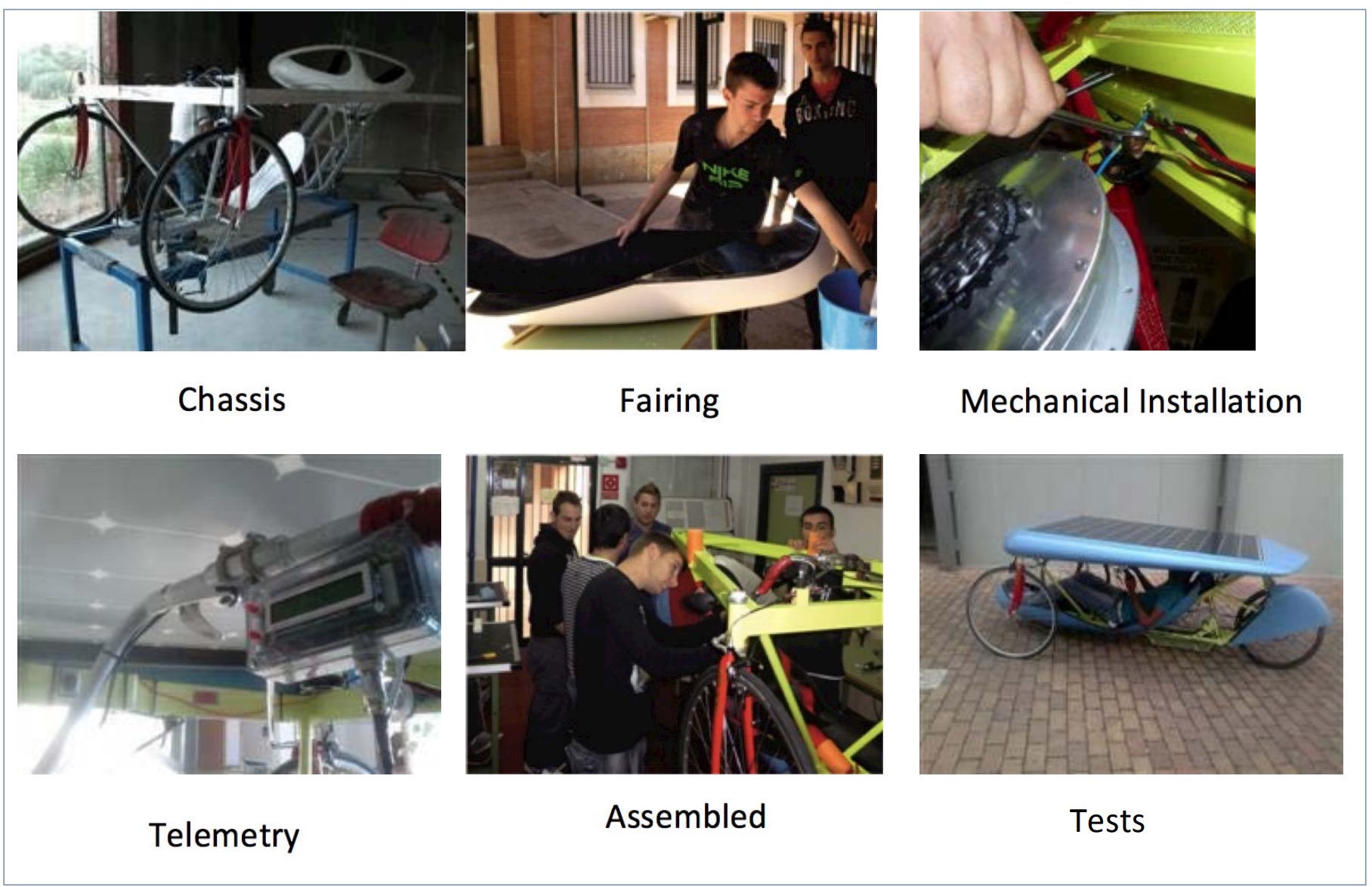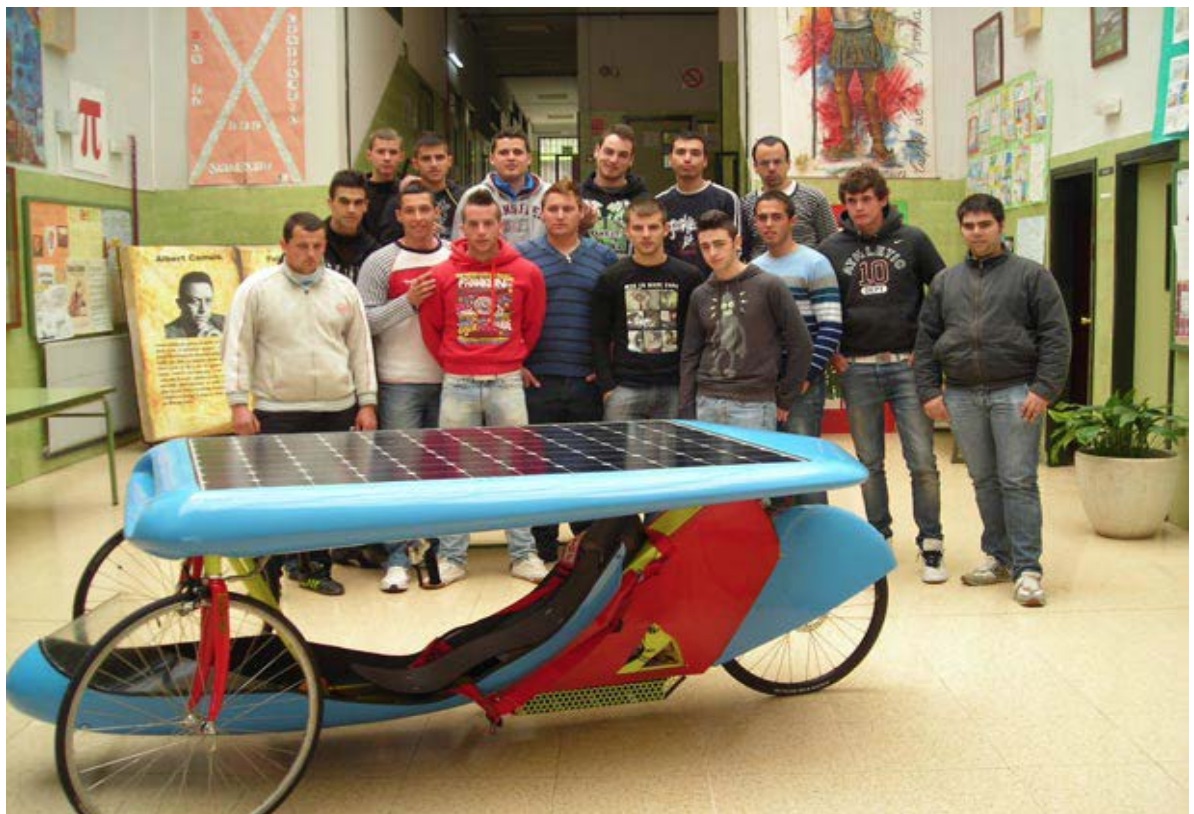Experimental Electric Vehicle at Almadén School of Mining and Industrial Engineering
Vehículo Experimental Eléctrico en la Escuela de Ingeniería Minera e Industrial de Almadén
Ángeles Carrasco García1, José Tejero Manzanares2, Julio Alberto López Gómez3, Xiaoxin Zhang4, Raquel Jurado Merchán5, Elena Beamud González6, José Manuel de la Cruz Gómez7 , Eduardo Palomares Novalbos8, Francisco Mata Cabrera9
Abstract
Almadén School of Mining and Industrial Engineering (EIMIA) has been working on energy efficiency and photovoltaic solar energy for some time now. We have participated in several teaching innovation projects related to electric vehicles. In the academic year 2021/22, prototypes have been improved from the mechanical, electrical and control point of view.
Keywords: Energy efficiency, photovoltaic solar energy, electric vehicles, teaching innovation.
Resumen
Desde la Escuela de Ingeniería Minera e Industrial de Almadén (EIMIA) se trabaja en materias de eficiencia energética y energía solar fotovoltaica desde hace tiempo. Hemos participado en diversos proyectos de innovación docente relacionados con vehículos eléctricos. En el curso 2021/22, se han mejorado los prototipos desde el punto de vista mecánico, eléctrico y de control.
Palabras clave: Eficiencia energética, energía solar fotovoltaica, vehículos eléctricos, innovación docente.
Recibido / received: 06/06/2022. Aceptado / accepted: 03/10/2022.
1-9 Universidad de Castilla-La Mancha. Escuela de Ingeniería Minera e Industrial de Almadén. Plaza de Manuel Meca, 1, Ciudad Real.
Autor para correspondencia: Ángeles Carrasco García; e-mail: angeles.carrasco@uclm.es
Introduction and objectives
In Almadén School of Mining and Industrial Engineering, a working group was created in 2019 with the idea of improving issues related to energy efficiency, sustainable development and working in a coordinated and transversal way the different subjects of our engineering degrees.
The main objective of this project was to create an aerodynamic single-seater vehicle powered by an electric engine with a complementary energy source based on photovoltaic modules for future participation in ecological competitions. Other objectives were to develop teaching activities based on the development of transversal competences that could contribute to achieving significant student learning outcomes. The methodologies used were the following, methodologies of great value as demonstrated by Amante et al. (2007), Alfaro et al. (2006), or Benito and Cruz (2005) in their work:
– Cooperative Work.
– Case studies.
– Problem-based learning.
– Project-based learning.
The guidelines followed throughout the project can be summarized as follows:
– Lowest possible cost using affordable and non-polluting energy.
– Theoretical project and real project of a prototype that could be used in sustainable cities and communities.
– Development of the first photovoltaic prototype with the aim of improving the production of environmentally friendly cars through responsible consumption.


Methodology
From the teaching point of view, the subject matter involved in a project of these characteristics entails the achievement of the main objective (designing an electric vehicle) and that the students could develop both specific competences (related to technical knowledge of the subject areas) and transversal competences (skills and aptitudes); the student being the axis of the whole teaching-learning process (De Miguel Díaz 2005; Villa and Poblete 2007).
For the design of the prototype, a planning divided into the following activities was followed:
– Coordination and definition of the fundamental components of the vehicle.
– Dimensioning and construction of the chassis.
– Dimensioning and construction of the fairing.
– Photovoltaic, electrical and storage system.
– Electronics and control system.
– Integration and assembly of the vehicle.
– Vehicle test protocol.
A detail of these activities is shown in figure 1. The work plan was based on creating mixed working groups between students and teachers who were dedicated to the realization of each of the individual activities. Weekly progress meetings were held, attended by all participants in the working groups, where the progress of each of the tasks was shared. The aim of these meetings was to help the students frame the work they were doing as part of the project as a whole and to increase their motivation.
Each and every one of the above activities followed a methodology based on the following aspects: approaching the problem, solutions to tackle it, and choosing the best solution. Firstly, by studying the problem theoretically, so that once it had been solved, it could be put into practice. To do this, we had teaching and research colleagues from the University of Castilla-La Mancha and IES Mercurio, in our town, all of them highly qualified in the thematic areas that make up the activities to be carried out.
Results and analysis
As a result of the above teamwork experience, the vehicle shown in figure 2 was developed.
The students actively participated in the design and construction of the vehicle. EIMIA students involved in the project developed their Final Degree Project on vehicle-related topics, for example, incorporating a telemetry system that sent the data collected by the vehicle’s sensors.
These active participation methodologies have contributed to the development of transversal competences that are fundamental for our students’ learning. They are highly motivated to put the acquired knowledge into practice. Competences are planned to promote learning.
Students learn to organize and plan their own time, apply knowledge to practice, develop information technology and management skills, learn to work in a team and also autonomously and, in short, they are trained as people capable of entering the labour market with all the guarantees (García 2009). The idea is to participate in a real competition in the future. To this end, sponsors and external funding are being sought. Taking part in real competitions brings advantages for the participating students. One of them is that students develop the ability to organize and plan the race. In addition, they must meticulously study all the details prior to the competition, so that on the day of the race, any mistakes can be minimized. They must also be able to apply their knowledge in practice: in a real-time competition, problems must be solved in real time, so they must also have leadership skills, decision-making, problem-solving, achievement motivation, and so on.
It should not be forgotten that students should always be assessed on the work they do. In competition, the evaluation is about achieving a good place. One of our goals for the following competitions is to be among the top 10 teams as in one of the last races we achieved the third position, so the evaluation was very positive and satisfactory for the participating students. Students should always be motivated towards constant learning.
Conclusions
– Students value problem-based learning and specific projects very positively and feel responsible for their own learning process.
– The realization and design of the car has allowed teachers and students to work on the different subjects in an interdisciplinary way, working cooperatively, and avoiding overlapping.
– A multidisciplinary research group has been created.
– By developing the prototypes designed, the technical capacity, coordination, effort, and dedication of all the members involved has been demonstrated in order to carry out a project of this magnitude in a relatively short time.
– This type of activity represents a change in the way students’ work is oriented; they are confronted with real situations, with specific problems that they have to solve in form and time in coordination with other students and teachers from different areas of knowledge. In this way, knowledge is shared in a broader way.
– The initial stage in the learning curve is slower than in more generic subjects, but the achievement of objectives leads to higher student satisfaction.
– The downside of this type of initiative is the problem of involving a large number of students; a great deal of coordination work needed between tutor teachers and the desirable means is not available. The economic factor is a major obstacle.
– From the research point of view, it should be noted that as a result of the work developed, the EME Research Group has been formed, with lines of work in Renewable Energies, Electric Mobility and Energy Efficiency and that the teaching team involved in this project plans to continue developing the vehicle in coordination with the students.
– Collaboration of companies in the energy and environmental sector that have believed in our project and have given us financial support.
– Our school has been made known to potential future students.
– Final degree projects related to electric vehicles have been promoted.
References
Alfaro, I., Apodaca, P., Arias, J., García, E., y Lobato, C. (2006). Metodologías de enseñanza y aprendizaje para el desarrollo de competencias: orientaciownes para el profesorado universitario ante el Espacio Europeo de Educación Superior. Madrid, Spain: Alianza Editorial.
Amante, B., Romero, C., y Peñuela, J. A. (2007). Aceptación de la metodología de aprendizaje colaborativo en diferentes ciclos de carreras técnicas. Cuadernos de Innovación Educativa en las Enseñanzas Técnicas Universitarias, 1(1), 65-74.
Benito, A., y Cruz, A. (2005). Nuevas claves para la docencia universitaria en el Espacio Europeo de Educación Superior: Narcea Ediciones.
De Miguel Díaz, M. (2005). Cambio de paradigma metodológico en la Educación Superior. Exigencias que conlleva. Cuadernos de integración europea, 2, 16-27.
García, M. J. (2009). Evaluación por competencias transversales. Universidad de Madrid.
Villa, A., y Poblete, M. (2007). Aprendizaje basado en competencias. Bilbao: Universidad de Deusto.

